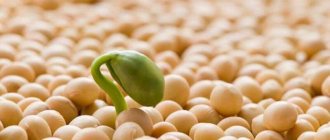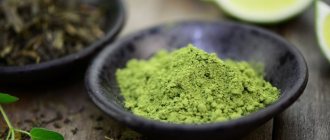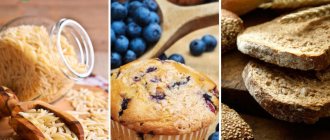Benefits and contraindications
- legumes contain many nutrients - protein, iron, fiber, zinc, folic acid, potassium, calcium, phosphorus, magnesium, B vitamins;
- studies show that 1/2 cup of legumes will provide 24% of the daily folate, 15% of protein and 20% of fiber; legumes are high in lysine, an essential amino acid that the body cannot produce alone;
- antioxidants in legumes, namely polyphenols, accelerate the elimination of toxins and help the body fight even serious diseases - cancer is also one of them;
- legumes consist of 80% complex carbohydrates - and they help avoid “spikes” in blood sugar levels, and at the same time type 2 diabetes;
- Legumes contain little saturated fat - the risk of increasing cholesterol in this case is minimal. Some legumes (soybeans, lentils, beans and chickpeas) also contain saponins and phytosterols - they reduce the level of “bad” cholesterol and the risk of developing cardiovascular diseases by 10%. How? The former combine with cholesterol and remove them from the body, while the latter, on the contrary, compete with it for the same enzymes that help them be absorbed.
In some cases, legume products can be harmful - here are a few contraindications.
Gastrointestinal diseases (gastritis, pancreatitis) - legumes often contain FODMAP carbohydrates - fermentable oligo-, di-, monosaccharides and polyols. The body has difficulty digesting these substances, especially for people with gastrointestinal diseases. Legumes will not harm them only if you completely remove them from the diet or leave a small part - but even in this case there is a risk of causing an exacerbation.
For those who suffer from gout, there is their own diet, and legumes are prohibited in it. The fact is that with this disease, metabolism is disrupted, and uric acid (slag) in legumes greatly complicates this process and affects the joints.
In case of allergies to peanuts and soybeans, legumes should also be avoided - the reaction is caused by allergens in their composition (profilin, glycinin, vicilin).
What dishes are prepared
From this legume product you can prepare many different dishes - bean salads, soups, and side dishes. Based on the quality of the ingredients and their proportions, the number of calories is determined. In recipes with exact proportions, we will additionally provide the calorie content and BJU of the dish.
White beans stewed with vegetables and chicken
(onions, celery, sweet peppers and carrots) and chicken fillet to pre-boiled white beans until half cooked Simmer everything together for 25-30 minutes. The dish is served hot.
Omelette with green beans
Beans (250 g) are fried in a frying pan for 6-8 minutes over low heat . Separately prepare an omelette mixture of 4 eggs, salt and 100 g of milk. The mixture is poured into a frying pan. Bake over low heat for 3-4 minutes. The calorie content of the dish is 358 kcal. BZHU = 30 g/20 g/13 g.
String (green) beans with mushrooms
Frozen chopped champignons and pods are placed on a heated frying pan . Salt, pepper, simmer covered for about 20 minutes until the liquid evaporates. The mixture is mixed with sour cream and simmered for another 5 minutes.
Stewed red beans in tomato sauce
For a glass of boiled beans, take 1-2 carrots and tomato sauce or paste. Add onions if desired. Simmer everything together for 15-20 minutes under the lid.
Bean lobio with walnuts
To prepare lobio, add onion, garlic, cilantro, basil and hot pepper to the boiled beans . Simmer everything together for 10 minutes. At the end, add chopped walnuts and let it brew for another 10 minutes.
Pate
For this dish, both boiled white or red beans and canned beans are suitable . It is minced in a meat grinder or blended in a blender along with fried onions or a clove of fresh garlic. Store in the refrigerator.
Cutlets
For 150 g of boiled beans, take 40 g of fried onion and 1 egg . Everything is passed through a meat grinder or crushed in a blender. Add flour (20 g) to the mass. Form cutlets, fry in a frying pan in oil (20 g) until golden brown. The calorie content of the dish is 593 kcal. BZHU = 25 g / 27 g / 62 g.
What are legumes best suited for - weight loss, muscle gain, healthy nutrition?
In general, a large amount of fiber in legumes improves digestion and cleanses the intestines, but here you need to know when to stop – its excess will lead to gas formation, diarrhea and a deficiency of fat-soluble vitamins A, D, E.
But complex carbohydrates in legumes will “save” you from overeating - they work “slowly”, that is, the feeling of fullness lasts longer. Simple carbohydrates, by comparison, immediately increase sugar levels, that is, they give a sharp boost of energy - and, if not used up, it will be deposited in fatty tissues.
How many calories should you eat to lose weight? Calculate in a special calorie calculator
Proteins are made up of amino acids and, unlike carbohydrates, are stored in the muscles. But gaining muscle mass only with the help of legumes, that is, plant proteins, will be difficult - the full composition of amino acids cannot be found in their composition (with the exception of soy). Therefore, it is important to combine legumes with cereals and sources of animal protein (meat, cottage cheese, eggs).
Contraindications
Frequent consumption of beans is not recommended for people with sensitive intestines and stomach diseases, as this can lead to microflora irritation, gas formation and bloating.
The purine substances they contain aggravate the symptoms of nephritis and gout, so eating beans is strictly prohibited for these diseases.
Other contraindications to eating beans include: flatulence, constipation, diseases of the gallbladder, pancreas. Elderly people and children should also consume beans with caution.
Be sure to read: Calorie content of pea puree per 100 grams: what determines how many calories are in peas with butter
How to get the most out of legumes - some tips
- Legumes contain antinutrients - substances that interfere with the absorption of certain nutrients - calcium, iron, phosphorus and zinc. These include lectins, phytates, tannins. The “side effects” from them are not the most pleasant - gas formation, bloating - this can be avoided, but then the legumes need to be soaked for 8-12 hours;
- If you don’t have time to cook and soak, you can buy ready-made legume products - fresh or canned. They will only need to be washed;
- It’s better not to go too heavy on legumes – ½ cup is enough to replenish all the necessary valuable substances. Excess fiber in legumes will lead to gastrointestinal problems;
- It is ideal to store legumes in containers, away from sunlight - in a cool and dry place.
LiveInternetLiveInternet
Investigation from Wild_Katze Part one Part two “Are there a lot of saturated fats and cholesterol in meat or how are nutritionists deceiving us” Part three “Is there a lot of potassium in vegetables and fruits or how are nutritionists deceiving us” Part four “Are there few nutrients in white bread or how nutritionists are deceiving us.” The vast majority of doctors and nutritionists, speaking about the chemical composition of products, claim that 1. Legumes contain a lot of proteins, even more than meat; 2. Meat is just a storehouse of saturated fats and cholesterol, and animal fat consists only of saturated fats; 3. Apricots, bananas and other fruits and vegetables contain huge amounts of potassium; 4. Bread made from white flour does not contain nutrients; and much more. But it’s not for nothing that people say: “Trust, but verify.” And besides, the old editorial wisdom calls for: “What is not verified is distorted,” so for now we will check these four statements of nutritionists. But first, a little introduction. In order to check the chemical composition of products, you need to find a suitable source of reliable information. Let's use the book Skurikhin I.M. and others (ed.) “Chemical composition of food products.” (https://spbgmu.me/liter/gigiena.html). This book is a fairly reliable source of information for checking the composition of food products, since the information contained in the book has been verified for accuracy, and the book is intended for specialists, not amateurs. However, doubters can conduct such an investigation themselves, using this or any other source of information. The main thing is that it is reliable. Data on the content of substances in different products were extracted from Skurikhin’s book and collected for comparison in several tables. All data is given in grams per 100 g of the edible part of the product, that is, the part freed from waste during cold cooking (peeled potatoes, boneless meat and fish, etc.). Or, which is the same thing - as a percentage (except for potassium, calcium and magnesium). Legumes and meat - which has more proteins? Strictly speaking, “more” or “many” and “less” or “little” are not absolute concepts, but relative ones, that is, one concept depends on the other. For example, we cannot say that a tablespoon of sugar (25 g) is a lot or a little, until we know what to compare it with. If we dissolve a tablespoon of sugar in a glass (200 g) of water and try the resulting result, it will turn out very sweet, which means 25 g of sugar per 200 g of water is a lot. And if we dissolve the same tablespoon of sugar in a 200-liter barrel of water and try the result, we will not notice the sweetness. This leads to the conclusion that 25 g of sugar per 200 liters of water is not enough. This reasoning preceded the following table 1. Table 1. Content of proteins, water and starch in legumes and cereals People interested in the protein content of foods usually pay attention only to the protein content, without paying attention to anything else. And in fact, if you look only at the protein content in legumes, then at first glance it will seem that there is more of them than in meat and fish. Table 2. Protein and water content in animal products Now let’s look carefully at the columns showing the water content in products. Common sense and the above example with sugar tell us that the more solvent (in these cases water) in the mixture, the less the main substance. That is, it turns out that legumes have an average protein content of about 22%, but with an average humidity of about only 14%, and meat and fish have an average protein content of about 18%, but with an average humidity of about 68%. But we don't eat dry legumes or grains. We cook them with a fairly large amount of water, which means the result is a product with a moisture content close to that of meat or fish. To find out how much protein will remain in the finished legume product, you need to recalculate its amount. For example, 100 g of dry beans contains 21 g of protein and 14 g of water. This means that everything except water in the beans is 86 g (100-14=86). We need to know the protein content of boiled beans if their moisture content is, like meat, 68%. That is, in the resulting product the content of everything that is not water will be 32% (100-68 = 32). This means 86 g is 32% of boiled beans, then 100% will be 286.75 g, and 1% will be 2.8675 g. It turns out that the protein content in the finished product will drop and become 7.81% (or 21 g: 2 .8675 g = 7.81%) or per 100 g of finished product (boiled beans) - 7.81 g of protein. In fact, the protein content will be even lower, given the inevitable losses during hot processing of the product. You can calculate the protein content in other legumes and cereals yourself. It should also be taken into account that dry grains of beans, peas and other legumes are fully ripened seeds with the maximum content of substances for this type. In unripe seeds (beans, very young soft peas), the content of proteins and other substances is much less than in ripe dry seeds, and the water content is much higher. Now, with equal levels of water content in products, you can compare the protein content in legumes and in meat and fish. All this and the results of our calculations can be easily checked by going to the store and looking at the protein content on cans of peas or beans or on packages of frozen peas and beans. Thus, we found out that in fact legumes contain noticeably less protein than animal products and that nutritionists are deceiving us. In a similar way, you can calculate the protein content in cereals. There will be even less protein, since there is noticeably less protein in cereals than in legumes. But with porridge we will get a large amount of carbohydrates, which, most likely, we do not need. Why does an office worker need the excess energy brought by carbohydrates that is suitable for a marathon athlete, lumberjack or miner? To be continued.
Series of messages “How nutritionists deceive us”:
We check how reliable the popular statements of nutritionists are.
Part 1 - Are there a lot of proteins in legumes or how do nutritionists deceive us? Part 2 - Are there a lot of saturated fats and cholesterol in meat or how do nutritionists deceive us? Part 3 - Is there a lot of potassium in vegetables and fruits or how do nutritionists deceive us... Part 12 - Anthony’s book Warner "The Angry Chef" How pseudoscience prevents us from eating properly" Part 13 - Refuting the horror story about the dangers of red meat Part 14 - Obesity: stigma and discrimination ruins everything
What is the bottom line – are legume products healthy?
Legumes are ideal to add to dishes; they can also be eaten separately, but the main thing here is not to overuse them. On the one hand, legumes prevent the development of diabetes, cardiovascular diseases and cancer. On the other hand, legume products have side effects and contraindications. Among them are problems with the gastrointestinal tract, gout, allergies. But, in general, legumes contain many valuable substances, minerals and vitamins - they cleanse the intestines, remove toxins, keep the immune system in good shape and reduce appetite.
More about training, nutrition, sports medicine and sports as an activity - in the “Health” section
Subscribe to the Sports.ru telegram channel about health
Photo: unsplash.com/v2osk, Miguel Andrade, Edgar Castrejon; globallookpress.com/J. Pfeiffer/https://imagebroker.com/#/search/
Harm of legumes
Eating beans in the diet is considered beneficial and has a beneficial effect on the organs and systems of the body. But it is worth noting that there are a small number of contraindications for eating these products.
These include:
- Elderly and children's age.
- Individual intolerance to the constituent components.
- The presence of diseases of the digestive and genitourinary systems.
- Pregnancy.
Also, all legumes are strictly prohibited from being consumed raw. They must be heat treated. If prepared correctly, any bean dish will not harm your health.
| Product | Kcal | Proteins, g | Fats, g | Angle, g | |
| China | 286 | 24,4 | 2,2 | 41,3 | |
| Mash | 300 | 23,5 | 2 | 46 | |
| Broad beans, unhusked, raw | 88 | 7,92 | 0,73 | 17,63 | |
| Canned chickpeas | 364 | 19 | 9 | 56 | |
| Mung bean peas | 300 | 23,5 | 2 | 46 | |
| Chickpeas | 309 | 20,1 | 4,32 | 46,16 | |
| Jicama | 38 | 0,72 | 0,09 | 8,82 | |
| Edamame | 147 | 12,95 | 6,8 | 11,05 |











